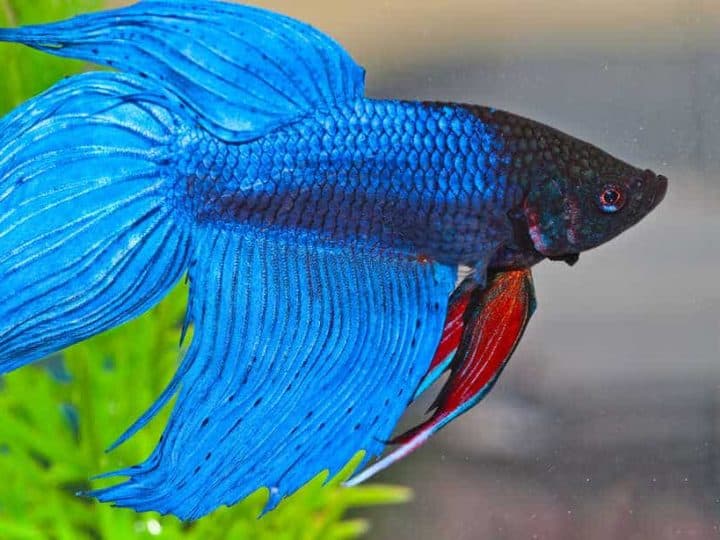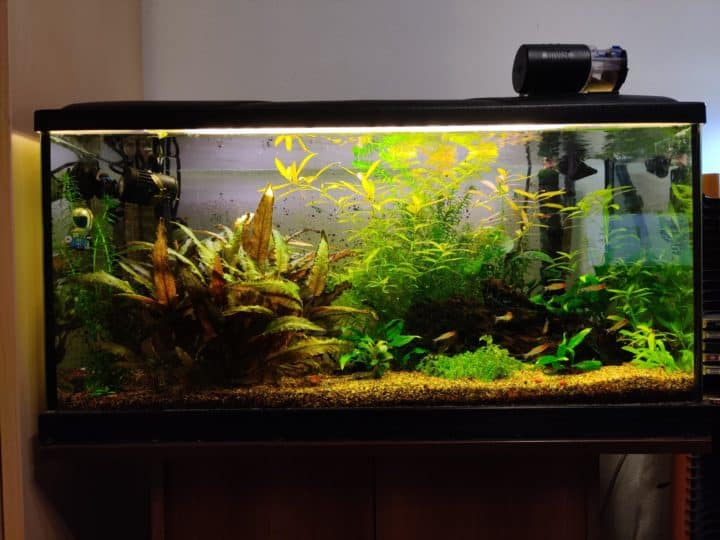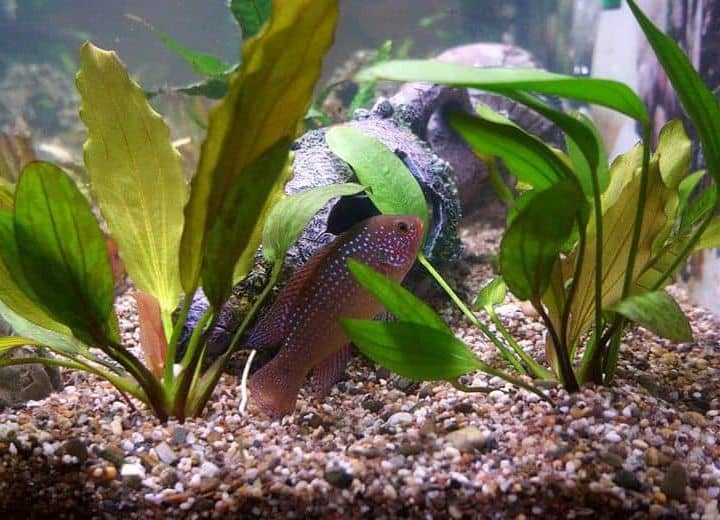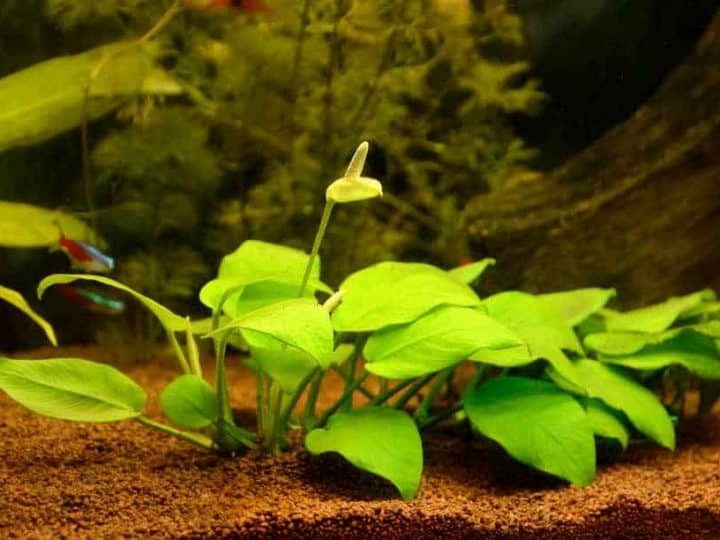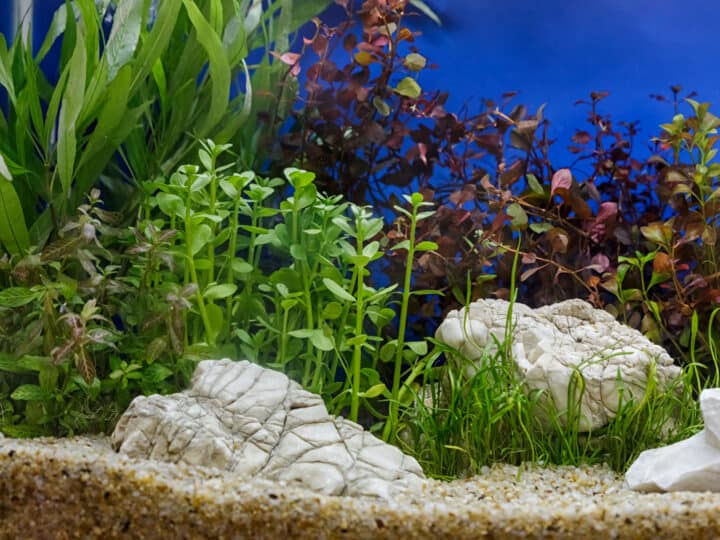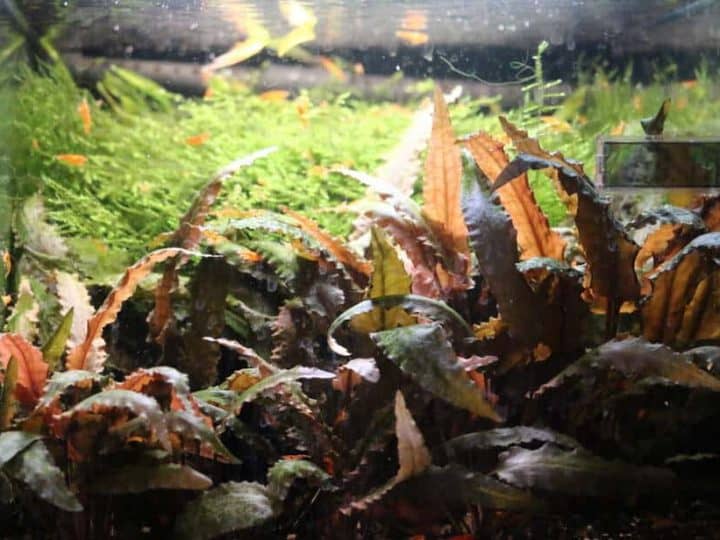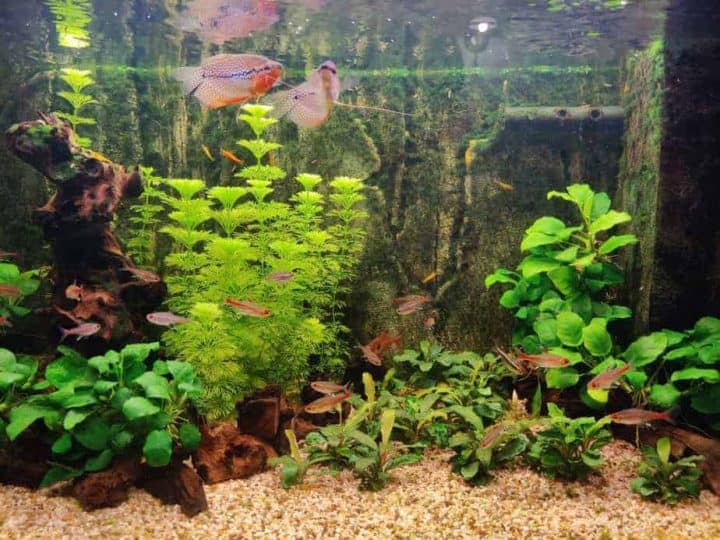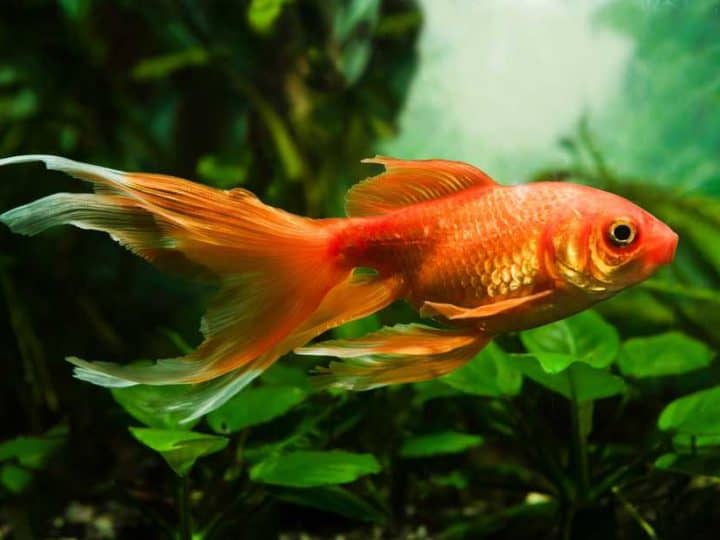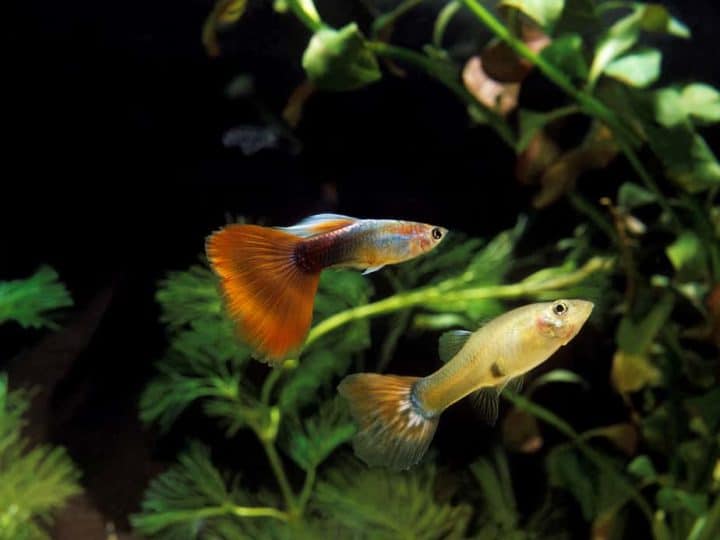Next to all the live plants that I have planted in my substrate, I wanted to experiment with attaching plants to wood and rocks. Today I’m talking about aquarium plants that will grow on wood and rocks.
Some of the best aquarium plants that will grow on wood and rocks include anubias, java fern, java moss, dwarf baby tears, African water fern, Christmas moss, and many others.
Keep reading to find out what the best aquarium plants that will grow on wood and rocks are.
- Anubias Barteri
- Java Fern
- Java Moss
- Dwarf Baby Tears (Hemianthus)
- African Water Fern (Bolbitus Heudelotii)
- Christmas Moss
- Riccia Fluitans
- Hygrophila Pinnatifida
- Bucephalandra
- Java Fern Windelov
- Java Fern Trident
- Anubias Nana
- Magenta Water Hedge (Alternanthera reineckii)
- Cryptocoryne Petchii
1. Anubias Barteri
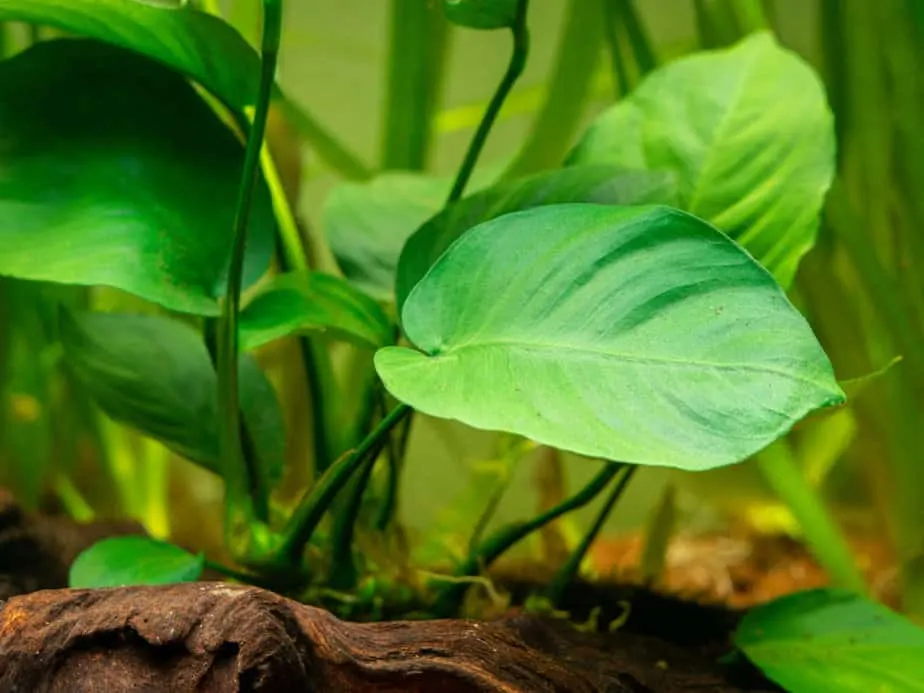
| Common name: | Anubias |
| Scientific name: | Anubias Barteri |
| Max height: | 16 inches / 40 cm |
| Care complexity: | Easy |
| Lighting needs: | Low |
| Growth rate: | Slow |
| Additional CO2 required: | No |
| Recommended position: | Midground / Background plant |
| Fertilization: | Liquid Fertilizer |
| Availability: | Buy on Amazon |
If you have already been doing some reading about this subject, of you already are familiar with some aquarium plants, you have seen this plant before.
It is the first one that comes to my mind when someone wants to attach a plant to driftwood, and it is my favorite type of aquarium plant.
Anubias plants have dark green leaves and are extremely sturdy. When I first held one, I almost thought it wasn’t an aquarium plant at all. The thick green leaves are beautiful.
Attaching plants to driftwood opens up so many possibilities! Not only are there different types of plants, but there are also many different types of driftwood. I’ve composed a list of 11 types of driftwood that are suitable to keep in an aquarium. Check it out here on my website!
Anubias Has Many Subspecies
One of the beautiful things about anubias plants are the many choices you have. There are plants with big leaves, but also plants with rather small leaves. Using the different kind of anubias plants you can create an entire aquascape on its own.
Here are some of the most popular subspecies:
- Anubias Afzeli
- Anubias Barteri
- Anubias Nana
- Anubias Gracilis
- Anubias Hastifolia
- Anubias Heterophylla
- Anubias Gigantea
If you are unsure which type to get I would recommend going to you local fish store and see what they have in stock. Because the plant is so popular they will probably have at least one type of Anubias plants in store.
2. Java Fern
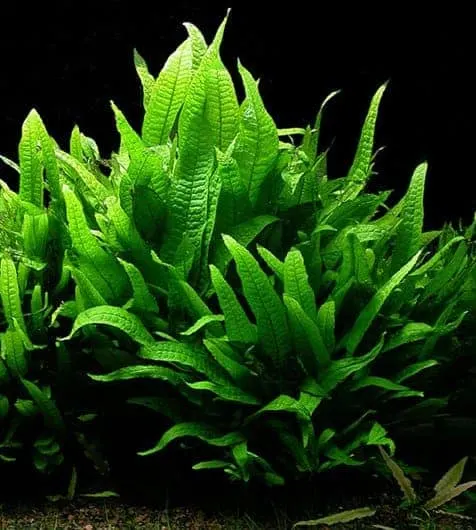
| Common name: | Java Fern |
| Scientific name: | Microsorum Pteropus |
| Max height: | 13.5 in / 35 cm |
| Care complexity: | Easy |
| Lighting needs: | Low |
| Growth rate: | Slow |
| Additional CO2 required: | No |
| Recommended position: | Midground / Background plant |
| Fertilization: | Liquid fertilizer |
| Availability: | Buy on Amazon |
The second option, and another extremely straightforward and logical option, is the java fern. The java fern is another easy plant that does well with low to medium lighting. Just like the anubias plant, java ferns prefer to get their nutrients straight from the water and do not rely on their roots/substrate for food.
They are slow growers and therefore do not require a lot of nutrients. Adding fertilizer will likely prevent brown spots in the leaves.
They don’t even do well with their roots buried, and thrive when attached to something like driftwood. The wood will make sure that the fern stays in the same place.
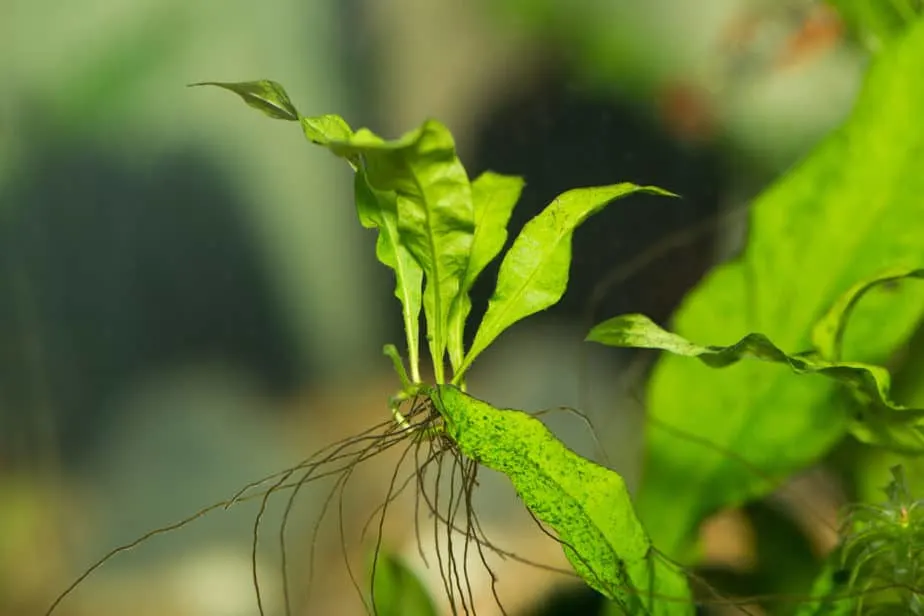
To attach a java fern to a piece of wood, you can use superglue of fishing line to tie it to the wood. With java fern you do not have a study rhizome as a base to glue the superglue so I would go with fishing line for this plant. It depends on how big the plant is. For small ones, try and use superglue first.
There are a variety of java ferns available, but your local fish store will most likely only have the “Microsorum pteropus” in stock. This is the most common type in the hobby.
Other varieties that you might encounter are the trident java fern or something like a “petit” java fern with smaller leaves.
If you java fern is not doing well, it might be because you have too much current, you have buried the roots, there is too much intense lighting or there are no nutrients in the water. In general this plant is rather easy to take care off.
Note that a lot of these plants are also in my “beginner plants” list. Check it out here! 🙂
3. Moss
To be completely honest with you, I struggle in describing all the possibilities you have with moss. First off, there are different kind of mosses available in our beautiful hobby. The most popular hand down is java moss but there are so many other types.
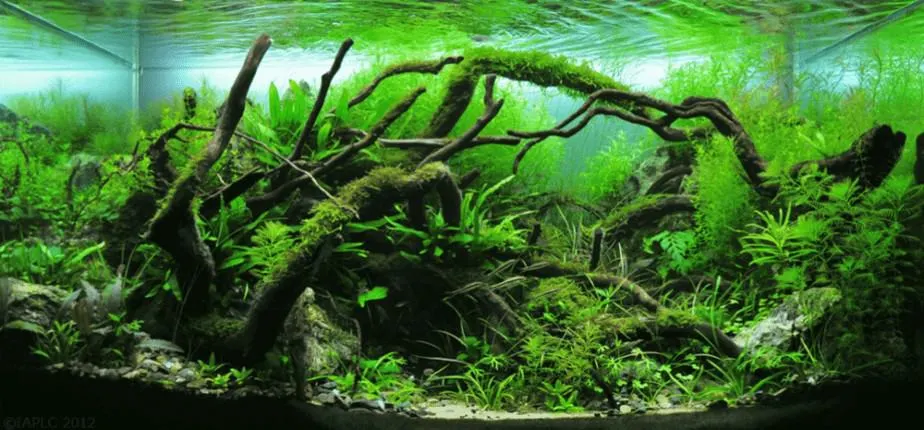
Again, here is a short list:
- Willow moss
- Weeping moss
- Flame moss
- Mini Taiwan moss
- Christmas moss
- Peacock moss
- Taiwan moss
- Cameroon moss
- Star moss
- source of this list
With all these different kinds of moss, but also with just java moss, there are many different things you can do. Attaching to driftwood is definitely one of them.
To do this, take fishing line and tie the moss to the driftwood. At first, it will not look as beautiful as you imagined it would be, but it needs time. Over time, the moss will grow and find its way.
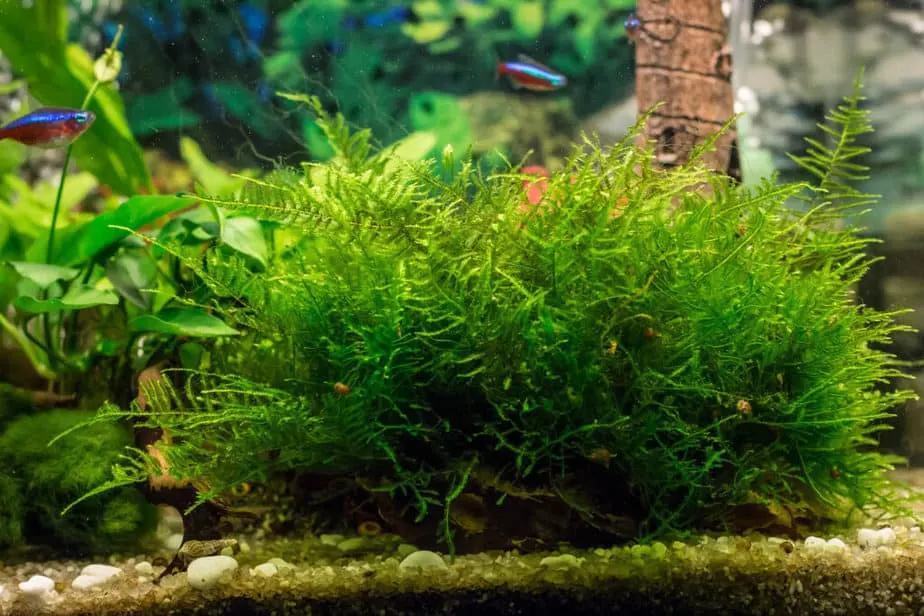
You’re actually able to order java moss online, which is a privilege few of us knew we had. You can order small plastic containers, just like you buy moss in the aquarium store. Check out this listing on Amazon! If you buy through my link you even support me and this website without additional costs for you.
If you are thinking of getting some new plants and you pull the trigger, I’m very grateful. Learn how to make a moss wall right here!
4. Hemianthus (Dwarf Baby Tears)
The previous three options were the mainstream options that most likely are readily available in a fish store close to you. These two options are a bit less popular, but still definitely work.
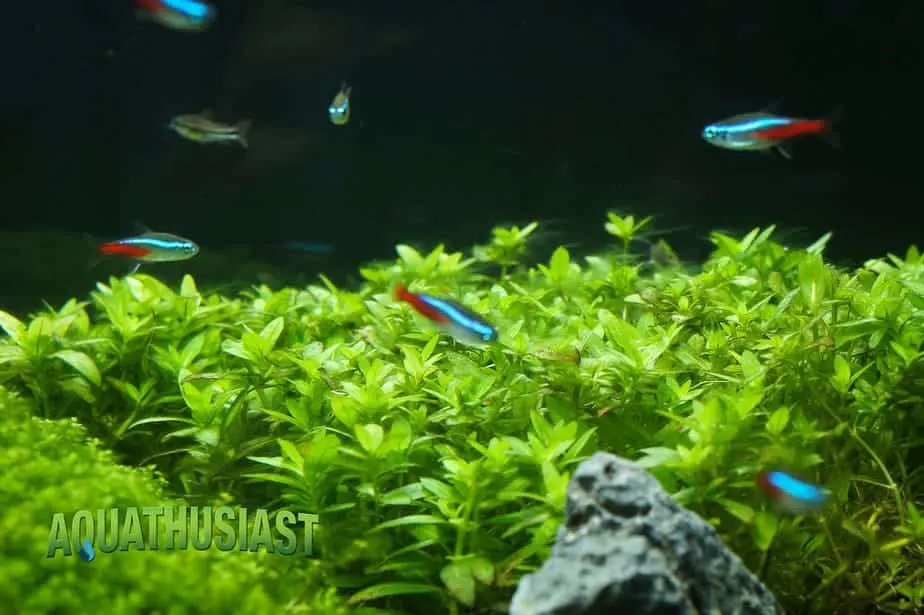
This one, called ‘dwarf baby tears’ is a plant that only does well with high lighting and the right nutrients. Only get this plant if you know you can provide it with this.
If the plant is not getting enough lighting, it is going to grow up instead of creep around like it is supposed to do. This really is a plant that requires a high tech aquarium to grow.
Now I know this is little information compared to the other plants in the list, but that is because I still need to learn a lot about this. There are many videos on youtube about this plant, so I will link one that I found useful.
5. Bolbitus Heudelotii (African Water Fern)
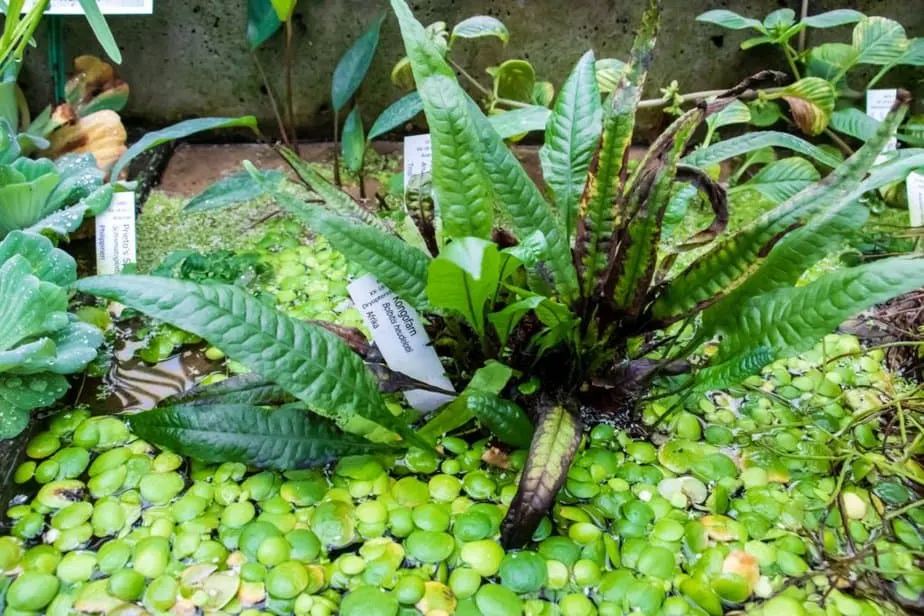
The African water fern is yet another aquatic plant that grows from a rhizome. The rhizome can easily be attached to something like a rock or a piece of wood. You can do this using the superglue I talked about earlier.
Note that rhizome plants like the Arican water fern or Anubias do not do well when they rhizome (the thick part at the base of the leaves) is buried in substrate.
The African Water Fern is a plant that I can not wait to get my hands on for one of my own aquariums. Up until now I have not been able to find it in my local fish store. I have read a lot about this plant online, and it seems to be an easy to care for plant that does not require additional CO2 and high lighting.
If you own this plant, I would love to know your experience. Is it a hardy plant? Does it do well under low to medium lighting? I have read that it does, but I would love to know from someone’s experience.
6. Christmas Moss
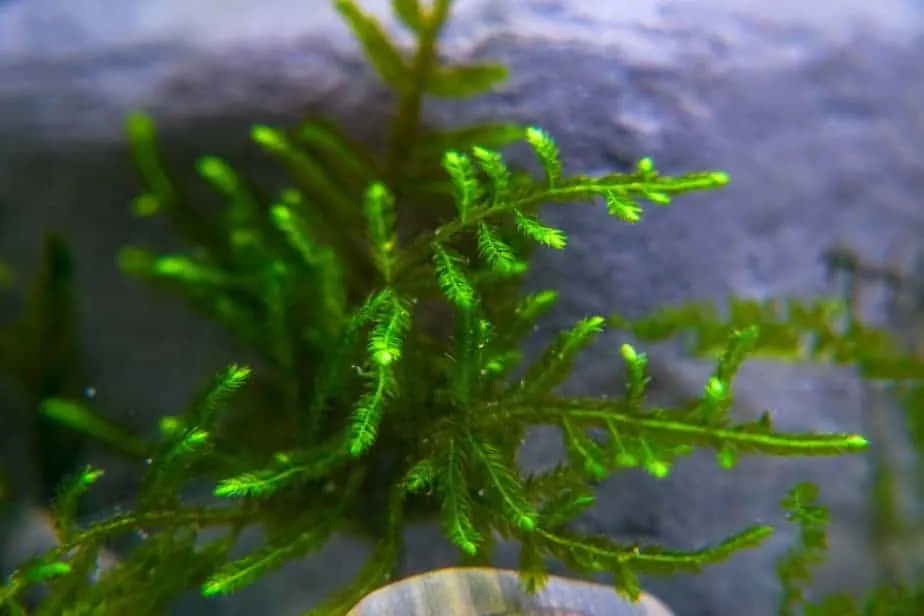
Christmas moss is similar to java moss, described earlier on the list. But nevertheless, each type of moss has its own characteristics. While java moss is most common and popular, many people use christmas moss in their aquariums.
I believe the name “Christmas moss” is derived from the look of healthy christmas moss. It looks like the needles of a christmas tree! Overall a great addition to any tank.
To learn how to attach this plant to wood or rocks, read the tutorial at the end of the article.
7. Riccia Fluitans
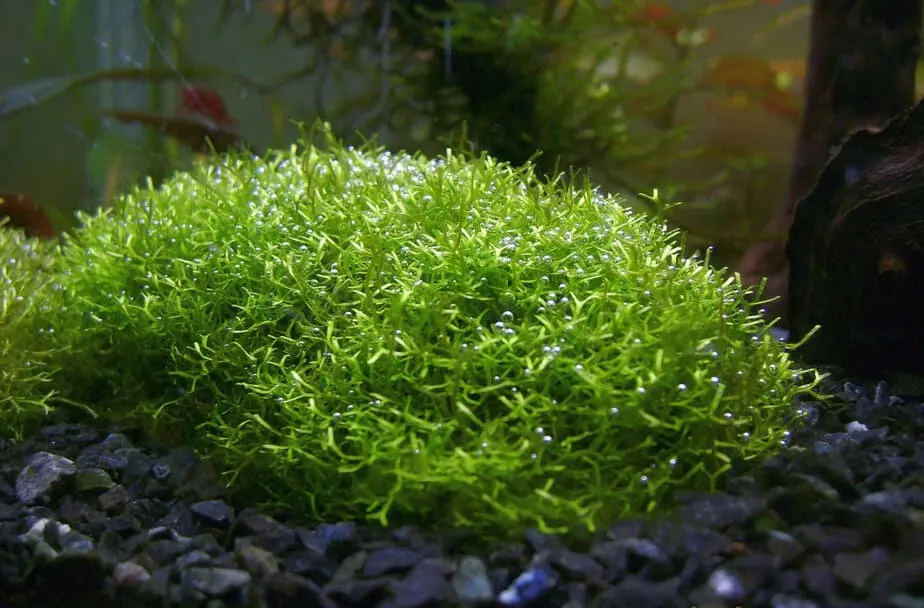
Riccia Fluitans is commonly known as crystalwort. It is actually a type of moss, and famous aquascaper Takashi Amano made it popular a long time ago.
Overall, this is a great plant to grow on rocks or wood, but you are going to need additional CO2 and quite bright lights. If this is possible in your situation, use this plant! It has a unique texture.
8. Hygrophila Pinnatifida
9. Bucephalandra
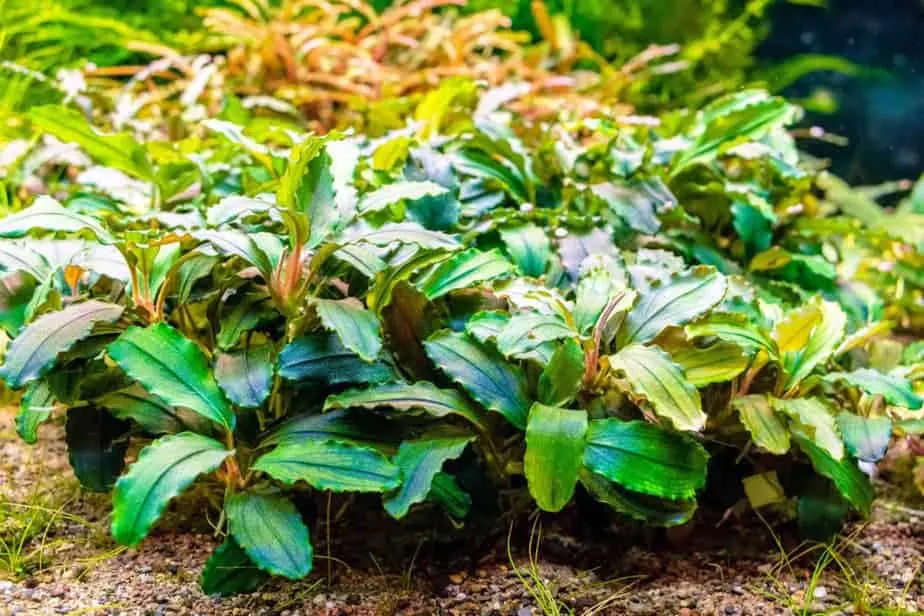
| Common name: | Bucephalandra |
| Scientific name: | Bucephalandra |
| Max height: | 4 in / 10 cm |
| Care complexity: | Easy |
| Lighting needs: | Low |
| Growth rate: | Slow |
| Additional CO2 required: | Not necessary |
| Recommended position: | Foreground / Midground plant |
| Fertilization: | Liquid fertilizer |
| Availability: | Buy on Amazon |
One plant that’s become more popular in the recent years is called bucephalandra. There are several bucephalandra varieties, but overall they are a great plant for beginners for a couple of reasons.
Do you remember the word ‘epiphyte’ from earlier? Bucephalandra also does not need to be buried in the substrate with its roots. It even does better when you don’t do this. It’s able to absorb the nutrients straight from the aquarium water.
10. Java Fern Windelov
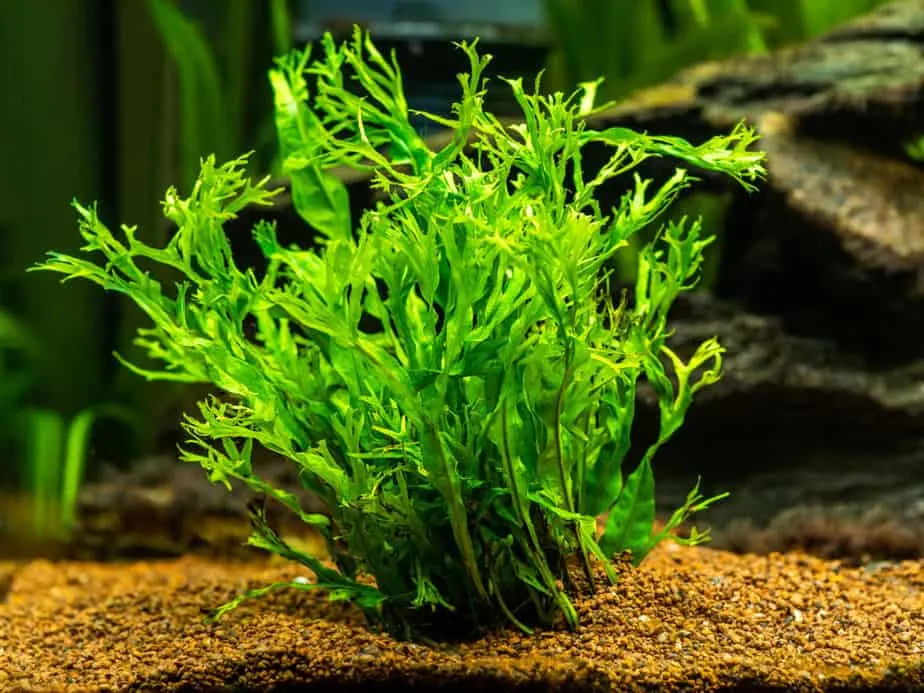
Varieties you should definitely check out are the “narrow leaf java fern”, as well as the “java fern windelov”. Together with the more common Java Fern you’ll be able to add phenomenal background plants to your aquarium. If you’ve got a bunch of driftwood, I recommend attaching the ferns to it using superglue.
11. Java Fern Trident
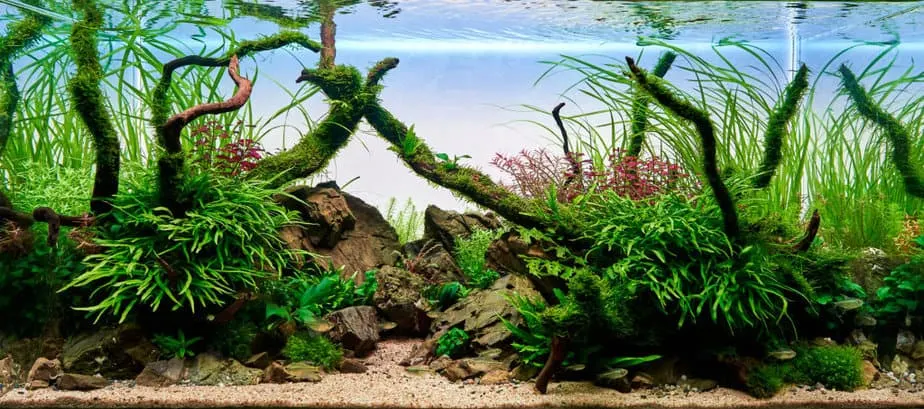
Usually known by its common name, the Java fern trident is a popular alternative to consider, and it has its name due to the fact that the leaves are often split into three parts, like a trident. it makes for a decent foreground plant but is often use by people as midground plants, it has a moderate growth rate, and it really adds some beauty into the water column.
12. Anubias Nana
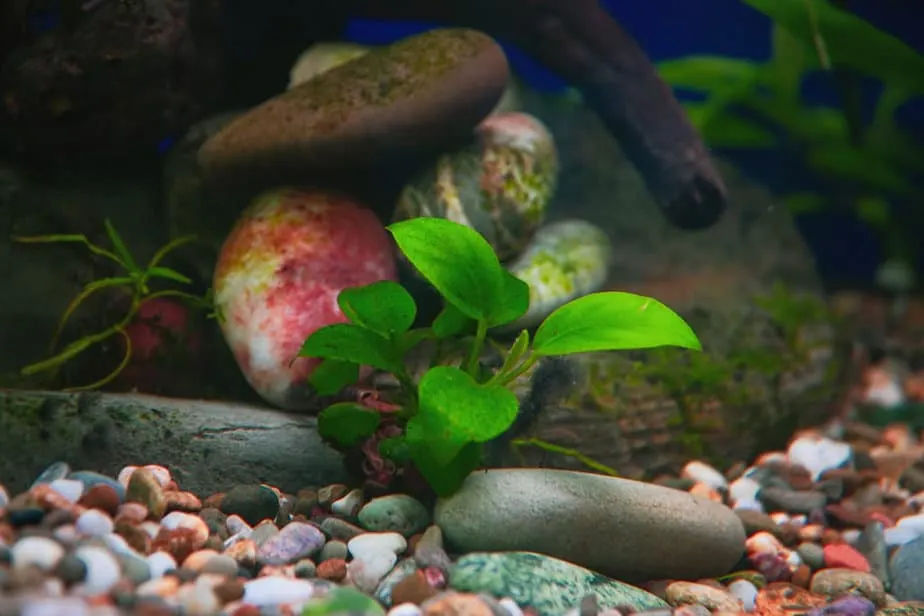
If you’ve looked around for some plants before I’m sure you’re familiar with Anubias plants. These plants have beautiful sturdy green leaves and are a great addition to any aquarium, also for planted discus tanks. The dark leathery leaves will look absolutely phenomenal in any tank, especially if you use some root tabs to supply them with extra nutrients.
13. Magenta Water Hedge (Alternanthera Reineckii)
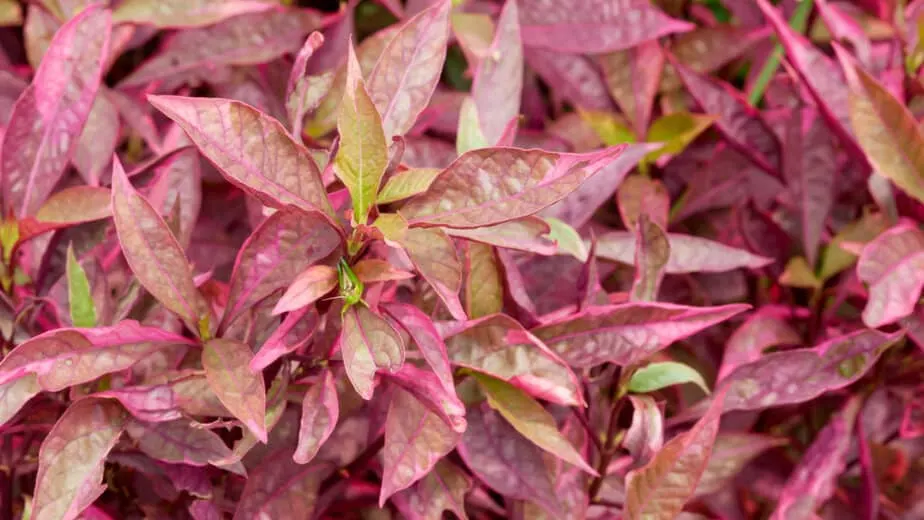
Here we have a super popular aquarium plant known for its bright pink and red hues. The important thing to note about this particular plant is that it does require some care. It requires a good deal of light, it does well with supplemental nutrients and CO2, and it prefers fairly specific and constant water parameters too.
14. Cryptocoryne Petchii
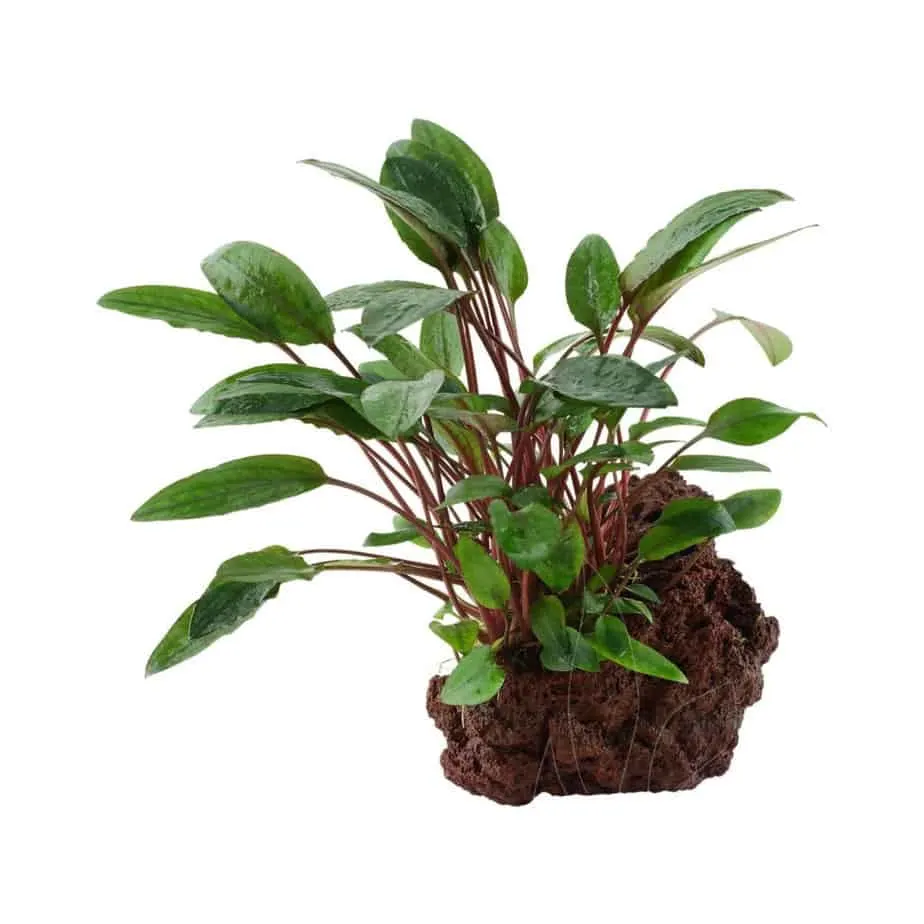
The crypt petchii is a fantastic plant to consider, one that works well in an aquarium or terrarium. It’s an easy to care for plant with simple progagation. With some basic nutrition and medium light requirement, it’s an easy plant to care for, one of the best tank plants as far as I am concerned.
How to Attach Plants to Wood and Rocks
If you are looking for plants that grow on wood and rocks, you are in the right spot. But how do you actually attach these plants so that they do not float away or get loose in other ways. There are several options for this.
Superglue
The first one is superglue. Yep, superglue. I thought that superglue would maybe dissolve or be toxic and kill the fish but neither is the case. There are a couple of precautions you should take in order for this to work.
First of all, make sure the plant and the wood are relatively dry. They should not be completely dry, but you need to wipe them with a piece of cloth for example. Also, make sure the superglue has had sufficient time to dry and stick.
I have been impatient in the past and my anubias plants would simply drift loose. This is rather frustrating I can tell you.
So am I sure that regular superglue is safe to use in aquariums? Yes. When super glue comes in contact with water it polymerizes in 30 to 45 seconds. It will not spread in the aquarium and kill all living things in there. All you need to do is make sure you wait around 5 minutes for the glue to properly cure before you put it back in the tank. I’ve answered this question in much more detail here on my site.
So what in what other way can you attach your plants?
Fishing line
The second way to attach plants to driftwood is by using fishing line. This is especially useful when it comes to attaching moss. I know I am already spoiling a couple of the plants that are suitable but that is no problem.
Attaching moss to driftwood is easy. Just spread the moss you a little and keep it in place using fishing line. After a couple of weeks the moss will have itself attached to the wood, and it will grow so much that you can not see the fish line anymore.
As for what fishing line, you can use the cheap and thin ones as there will be no extreme forces that the fishing line should endure.
Also, if you do not want the fishing line in your aquarium it is possible to carefully remove it when the moss has settled in properly. This is because the moss will firmly attach itself to whatever you tied it to.
But beware, you will probably feel like a surgeon removing the moss because you do not want to rip everything loose.
The Importance of a Good Plant Fertilizer
Before we kick off the list, there’s something you must know. None of the plants on the list can rely on their roots for nutrients. That would be a problem if the only source of nutrients is in the substrate. Luckily, there is a way to add nutrients to the aquarium water through a liquid plant fertilizer.
Adding fertilizer is really important, never let anyone tell you that just the poop from your fish is enough to sustain your plants. In fact, I wish I started dosing liquid fertilizer sooner because my plants really did way better after.
Liquid fertilizer does not have to be expensive. I always recommend API Leaf Zone, which is available here on Amazon. If you don’t have any fertilizer yet, do consider it because it will prevent you from having to buy new plants regularly.
Now, let us get into the list of plants that are suitable to attach to wood and rocks. The first three are rather common and in my opinion the easiest to take care of (although I have managed to kill all three in the past).
The last two are a little bit more uncommon and require more experience and more effort to keep.
References:
Feature image – Author: Local River Licensed under: CC3.0 No changes made
Java moss aquascape image – Author: Duc Viet Bui Licensed under: CC4.0 No changes made

